

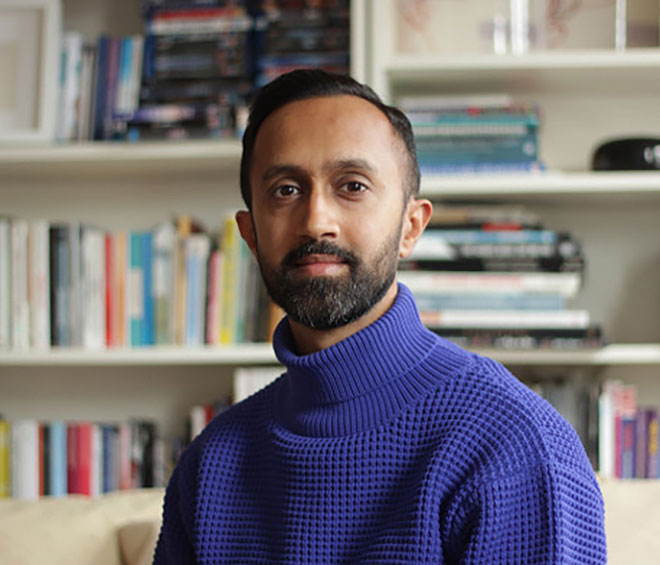
Hetain Patel. Photo courtesy Hetain Patel.
by CLEO ROBERTS
Hetain Patel works with the structures of theatre and film to search for “authentic” identity and point to all its fictions. Born in Bolton in 1980 and growing up in a household with Gujarati traditions, fantasy worlds conjured up in sci-fi and superhero stories shaped his aspirations, and his impersonations of these characters formed a strategy for acceptance among his peers. His photographs, digital drawings, sculptures, videos and live performances, which often feature the artist, draw on this childhood tendency to impersonate and follow the framework of mainstream entertainment. His images are conscious of their showmanship, sculptures overperform and videos are slick mimics of high-end productions.
In his live shows, Patel is malleable and multiple. He enjoys playing up to the audience. He is like a comedy impersonator with Jim Carrey elasticity, and pieces such as American Boy (2014) see him bounce from character to character, exploring cinematic ideals and the extent to which they have shaped him. With skittish charm and gestural dexterity, he is in turn X-Men, Michael Caine, Bruce Lee and Batman delivering a monologue peppered with light humour and eliciting fast laughs. These fade and leave lingering questions about racial representation, “identity” and associated prejudice.
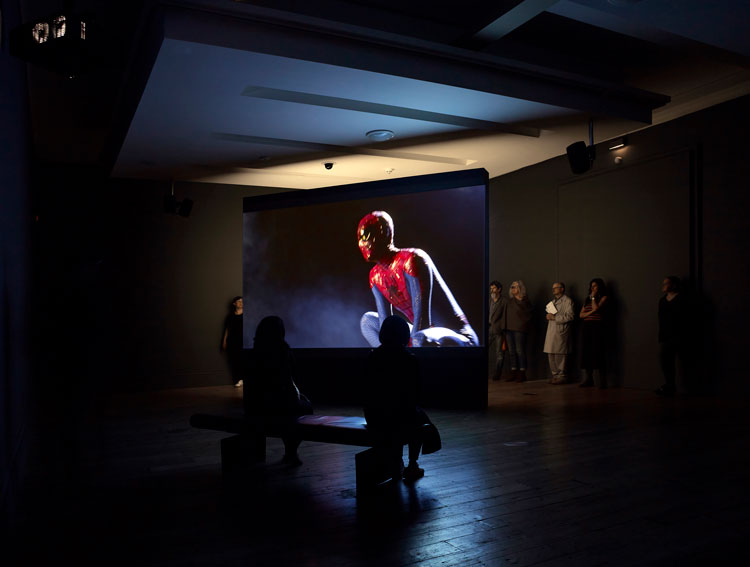
Hetain Patel. The Jump, 2015. 2 Channel HD video installation with sound. Courtesy Manchester Art Gallery.
The Jump (2015), a two-channel video installation, is a similarly smart deconstruction of his superhero fascination. In this domestic epic, a gangly Spider-Man undertakes a slow seismic jump and lands on an ornate carpet in Patel’s grandmother’s living room. The image of the quintessential action man in front of chintzy sofas crowded with his family is an awkward situation that speaks to Patel’s adolescent desire to transform and transcend his ethnicity.
Patel did a foundation studies course in art and design at the University of Salford and a BA in fine art at Nottingham Trent University. He has performed and exhibited at Tate Modern (2012), New Art Exchange, Nottingham (2012), Ullens Centre for Contemporary Art, Beijing (2012), Serpentine Gallery (2014), Sadler’s Wells, London (2015), Chatterjee & Lal, Mumbai (2015), and Barbican London (2019), amongst others. He won the Film London Jarman Award (2019). He is a Sadler’s Wells New Wave Associate, patron of the Quad Gallery, Derby, a visiting lecturer at Nottingham Trent University and member of a-n Artists Council.
In this interview, Patel discusses how he arrived at performance and the flexibility this gives him, as well as the wider challenges his comedic approach poses for his reception in the contemporary art world.
Cleo Roberts: You are such a comfortable and consummate performer. Was this a medium you began exploring during your BA?
Hetain Patel: Performance came way after graduation. I didn’t go anywhere near that during my BA. I was very shy. The things I was doing towards the end of my course were large-format photography. Looking back on it, it was performative in a different way; pigment and henna were applied to my face and body to form self-portraits. Initially, they were exhibited as large-scale photographs. My tutors said I should try video and live performance and I hated that idea. It was about the photograph; I didn’t want to reveal the process. It was a way for me to parallel the way I was fed Indian culture, having been born in the UK. My siblings and I were raised with the ideals of my parents’ India, without having lived there ourselves. Similarly, in my work, the photograph was the end product from a performative process that the viewer doesn’t get to experience.
However, as time went on, I got frustrated by the distance I felt between the work and the audience, so I started doing time-lapse videos of the bit before the photograph and I started doing those parts as performances live in galleries.
CR: You now seem to have fully embraced transparency through your amusing YouTube channel, which gives behind-the-scenes footage of your films, features a series of frank, informal conversations, and parodies instruction videos. Why did you turn to this platform?
HP: With any medium and with any context I use, I’m often a consumer first and frequently an obsessive one. YouTube definitely falls under [that category] for me. I’m always interested in engaging with the media I consume – I receive in that language, so I also want to speak in that language. I’m also interested in the audiences beyond art, for lots of reasons, including accessibility. On YouTube, everyone can access it – but, typically, if the arts use YouTube they don’t often get it right. Meaning, you can’t just put a still camera of an hour-long performance and expect people to watch it.
On the surface, it looks easy to create a four-minute video, but it’s really hard. You have to be interested in the language of YouTube, so, for me, it’s about taking it seriously and being respectful of this democratic space and doing something I care about.
CR: It is an oddly open space and when watching your videos, the algorithms suggest related content. It is interesting to see the aspects of your work picked up. There is also a specific language and conduct. Do you play with this?
HP: “How to” is one of the most searched for things. You can find any “How to”. It made sense to think of a series of “How to” videos and discuss my work within it. Humour has been a part of my practice for a good while and I do enjoy performing. I like that medium; the directness and accessibility. But I could never just do YouTube, it would drive me nuts. I’m not interested in exposing myself all the time and broadcasting myself every day, nor pandering for advertising. Fair play to those people, it takes a lot of work. It’s an aspect of my practice and I always love the challenge of whether I can take an idea and translate it for different contexts and different media.
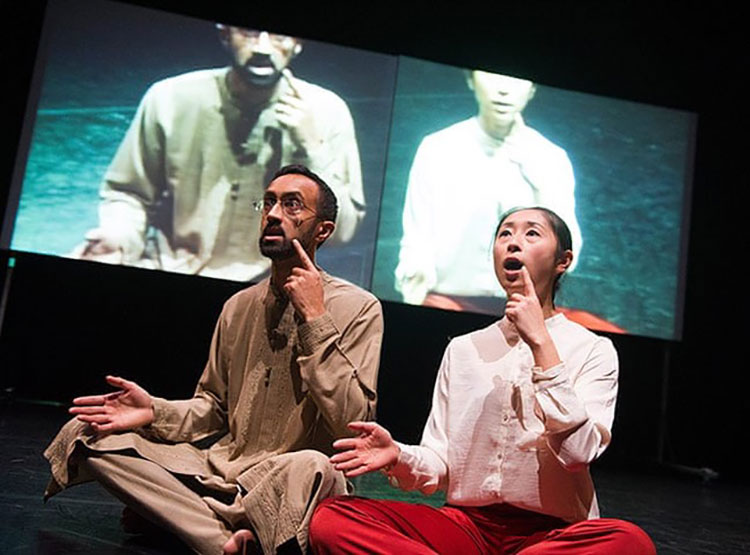
Hetain Patel. Be Like Water, 2012.
Live performance, touring theatres in 2012-2013. Photo: Tristan Kenton.
CR: You have also done a Ted Talk that has an incredible amount of views. It is another medium you would not usually associate with contemporary art. How did it come about?
HP: The genesis of it was an hour-long live performance that I’d made, commissioned by the Royal Opera House, New Art Exchange and Dance4 called Be Like Water. When I premiered that in 2012, there was someone scouting for Ted in the audience and they got in touch. They wanted to see if I could make a shorter performance of that piece. At first, I was like: “No way. I’ve spent two years making that performance.” Obviously, I got over myself and it was the best decision I’ve ever made.
CR: Why? What was the impact?
HP: There are a few different Ted platforms. I did Ted Global, which is curated and invited by Ted. It was in Edinburgh. I didn’t know this at the time, but you have to apply for a ticket and, if you get through the application, you get the pleasure of paying around $5,000 (£3,965) for the four-day conference. The 800-seat auditorium is jam-packed and loads of people can’t get in. At first you think this is kind of gross, but then when you think of it, it’s kind of brilliant because all these talks which happen on these stages over four days are given free online and they’re not left as ideas. Because of the people in the audience, they can make the ideas happen. People are showing medical delivery drones that can reach places with no roads in Africa and they’ll meet someone who can fund it and make that happen.
When I went to do my talk, my worry was that I was a palate-cleanser in between talks. I was on the first day and I can’t explain to you how well it went down. That evening, for three or four hours I didn’t move, there were queues of people wanting to give me their business card. It’s the first time that I felt in my heart that art matters. We know that it matters, but I had it in my head that, for people outside it, they don’t care about it. There were people on stage talking about wiping out Aids and I thought: “Why would my performance matter in this context?” But people made me feel that what I was doing was important. That really blew my mind and then it went online and viral and people still contact me now from all around the world. It’s nuts.
CR: Aside from visibility, did access to this network help support other work?
HP: I met someone at the conference, Asha Jadeja Motwani, who generously ended up funding my next project, a sculpture called the Fiesta Transformer. Outside that, I’ve had so many people get in touch within and outside the arts saying they saw the talk.
CR: Let’s talk about that anthropomorphic car. Fiesta Transformer is just that: a hulking Transformer model made from a red Ford Fiesta. Is your link to cars through your father and an exploration of your paternal relationship?
HP: Cars in our family are in the blood. My father created vehicles for the funeral trade. Because of his work, any cars we had were always bought from the scrapyard of one of his mates, which he would make road safe – apparently. For me, the work is rooted in my relationship with my dad and the possibility of an intergenerational connection through the cars.
.jpg)
Hetain Patel. Fiesta Transformer, 2013. Various materials, including Ford Fiesta car. Courtesy the artist.
Fiesta Transformer was the third project I’ve done with him. The first was a video called Dance Like Your Dad in which I imitated my dad. I filmed him giving me a tour of his factory and I went away and learned all his movements and his words and had someone film me imitating him, in a dance studio, and then the videos play in synchrony next to each other. The second one was a live performance together as part of the opening programme of the Tate Tanks and we showed the film along with a live performative interview with my dad and my wife. In those two instances, I was bringing him into my world. With the Transformer, I wanted to go into his world. By making this sculpture together, I knew we’d have to be in a garage together for months, doing what he does. It was almost a way to take a three-month apprenticeship learning how to weld and cut.
CR: It must have also been more than that.
HP: Because of these projects, we have a different relationship now. My father is not someone I could sit down with and talk to about diaspora and identity politics. Through this work, he gets me. It’s through action. That was primarily what it was for. I joke that it’s a working-class Transformer because, for me, it’s an amalgamation of the squatting posture that is my working-class heritage from India and the ubiquitous working-class image of the Ford Fiesta car, which had been in our family as well.
CR: A lot of your family feature as bystanders in The Jump (2015), and you asked them to dress in wedding clothes. The wedding symbology is common with your other film, Don’t Look at the Finger (2017), which is built around a wedding ceremony. What is it about union that you wanted to explore?
HP: For The Jump, I was thinking less about a wedding and more about people getting dressed up and that’s what people get dressed up for. I was interested in how we perform and present ourselves. I didn’t choose what they wore and, as it happens, there are lots of blues and reds, which are in my Spider-Man costume. It was about performing your heritage, whatever that might mean. And something about pride and what it makes you feel like wearing those things.
Hetain Patel, Don’t Look at the Finger (trailer), 2017.
For Don’t Look at the Finger, before it was what you see now, the original plan was that The Jump was the first of a series of works shot at my grandmother’s home with a different genre of Hollywood film made in each room. The next one was going to be a kung fu fight between my brother and me in the dining room, again with my family watching. The aim was to premier the works at a show in Manchester in 2017, which was under the new north and south umbrella, celebrating 70 years since independence with artists related to India and Pakistan. My worry was that, for people seeing my work for the first time, with me in it and a load of Indians, there could be the assumption that my work is solely autobiographical, that it has to be me performing in it, and I hated that idea. So, I decided to change the ethnicity of the protagonists.
Once that decision was made, the rest developed as we went on. I wanted to think differently about what a union is. A lot of Indian weddings are thought of as a marriage of two families, not of two people – that aspect was important to me. Also, the idea that it’s a potential rite of passage – could it be presented as a wedding, but not be one? It seemed to offer up ways of not making commitments to certain specificities while also having a very familiar, recognisable thing going on, because I was going to put in lots of unrecognisable things in there.
CR: Before we talk more about the defamiliarising the familiar, I would like to pick up on your character strategy. Was it informed by the reception you have personally experienced in the art world, or conjecture?
HP: While I’ve always known it emotionally, it took me a long time to understand intellectually that the brown body in the UK is not a neutral body. That any deviation from the white body is automatically “other”. Despite the fact that I made self-portraits at art school, nobody told me how I would be seen in the artworld. I feel like one of my main struggles and challenges in my career is to be accepted and recognised as a British artist. In the past, I’ve had so many invitations to do shows to do with India or ethnicity, and even Indian touring shows where I’m the only non-Indian.
I feel things are finally starting to change (slowly) for me, and that is in large part to do with Don’t Look at the Finger. Despite it making complete sense to me, my not having an Indian cast in that film seemed to really surprise people. It seemed to disturb the often easy assumptions that get made around my skin colour’s relationship to my cultural heritage. Unfortunately, this is a common experience for people of colour in the west.
CR: Part of that positioning is that you are knowingly obscure. In Don’t Look at the Finger, you deploy gestural language and signing. Who is that meant to give access to?
HP: I like the idea that, different people will get different levels of access to different parts of the film, whether that’s dependent on your cultural specificity or heritage, or whether it’s to do with your language or gender. You allow different points of access. I really like that, it felt inclusive in a realistic way. Also, there are elements in there that you might not understand, but there are enough other elements in there which make you want to understand them and make you go towards understanding them. So, a deaf audience might have more access to the gestural parts and a hearing audience has the soundtrack and the sound foley. I was interested in the idea that access to that film was complex, but that it could still be enjoyed and engaged with on a good level by lots of people.
CR: Is the way you expertly use humour a facet of accessibility and a way of broadening engagement?
HP: It’s partly a way to give access to subject matter that can be difficult under the surface. But, also, because I can’t repress it, it’s who I am. Having said that, I did keep it at bay when I was starting out. I’ve always been really paranoid about my use of humour in work. I’ve had curators say: “Your sense of humour is very different”, as a negative comment. Because it’s funny? In the art world that’s frowned on. If you give someone a belly laugh, it’s often considered cheap and, despite all the layers that come with it, there are people out there for whom it would be a guilty pleasure.
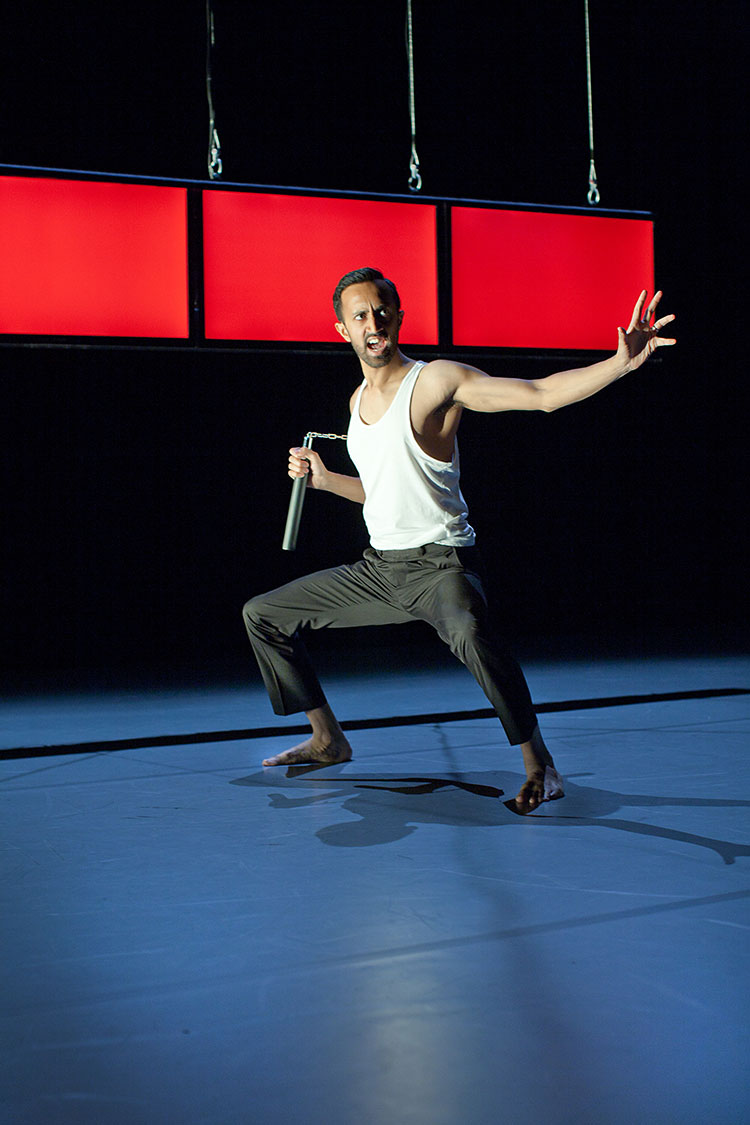
Hetain Patel. American Boy, 2014. Live performance, Sadler’s Wells, London. Photo: Pari Naderi.
CR: The theatre and performing arts world embraces you. You have toured the UK and internationally with American Boy (2014), Let’s Talk About Dis (2014), Be Like Water (2012) and Ten (2008-2012) at venues including Sadler’s Wells, Lancaster Arts, Sydney Opera House and Contact Theatre, Manchester. Does your work receive a different reception in the performing arts/theatre world? Is humour more permissible?
HP: Oh, absolutely! The contemporary dance world and the dance world generally is less snobby than the visual arts. But part of that is because there is a different history there on those stages. I’m always nervous. I joke that in London, people come to judge you. In regional theatres, people come to have a good time.
In the gallery, I’m aware that people vote with their feet. You don’t have to watch the whole film; you can leave if you want. So, what do I do about that? How do I make it so that they don’t leave? In a theatre, you can develop things a lot slower. People buy a ticket and commit to a particular time and day and you’ve got them for an hour. They’re very unlikely to walk out. So, you can do things differently.
CR: You have been at Sadler’s Wells as a New Wave Associate since 2012. Does this push your practice in different directions?
HP: You get exposure to shows and, through the network, you meet lots of performers and artists who, inevitably, you end up working with. That influenced the work massively. Also, being invited and accepted into the contemporary dance world gave me the confidence to consider that type of performance, which I never would have pushed otherwise. It was that world which said: “Hey, come and try this. We’ll support you and see what happens.”
It influenced not only a new kind of performance for me, but also influenced my wider practice. One of the reasons I had success in that field was my thinking as a visual artist, which informed the dance work. In the past, it’s been a good way of not taking things for granted and to not assume a common language artistically with anybody. The rules were completely different in performing arts, as is the audience. That naturally causes expansion in your thinking if you embrace that. All the smaller theatres who have supported me, they make a massive dint on the development of my work.
CR: Beyond the influence of the institution, are there particular artists who have informed your practice?
HP: My influences for performance are not in the arts. They’re Eddie Murphy, they’re The Simpsons. This is what for me is genius performance. Because I find a lot of it audacious, which is always an exciting place for me to be in my work. In the 80s, when Murphy, as a black man, was able to be as pop culture as they come while also joking about race was just mind blowing. That’s where my thing is. I like the craft of that. There is so much about that performance which gets easily written off because it’s entertaining. In Coming to America, imagine at that time (1988) making a virtually all-black cast, high-budget Hollywood film presenting black people as royalty.
CR: Murphy is a master of morphology, often playing multiple characters in one film. You can see marks of this in your work: you are leaping through identities and juggling with various representations. With your extensive portfolio of imitations, where does it leave space for you?
HP: I never think about that morphing as an avoidance of me. I find that those are the jigsaw pieces – it’s what the construction of me includes. I find those things make me be truer to me than not having them. I’m being more conscious of what I’m trying to avatar myself into and thinking about why I’m interested and attracted to that.
Imitation is useful and imitation in lots of ways – in the way I photograph, sculpt and draw – all has a level of imitation in it. What I get from that is imitation is a practice of empathy and a way of listening, of properly listening, not just with your ears, but with your body. For me, that process feels like a process of limbering, of stretching my muscles, my joints, my electrical signals, which previously I considered dulled. In all the imitation things, I don’t stay in them. Outside of intellectualising it, physically and emotionally I find it so satisfying, joyful and obsessive. I can’t control it sometimes. It speaks to my soul, vibrating your atoms in the same rhythm as something else. Everything is instinctive first.
CR: You have gone beyond the ephemeral characterisations and manufactured yourself into a doll.
HP: I think you mean an action figure.
CR: You make a good point!
HP: One of things I’m playing with in that and some drawings, which come from it, is this jokey reaction to the term “dolls” or “action figures”. It’s so misogynistic and there are value judgments about each, but they are the same thing for better or worse. What you’re allowed to like as a boy or a girl is fed into us. An aspect of the figures is exploring that stuff and partly to unwire some of that.
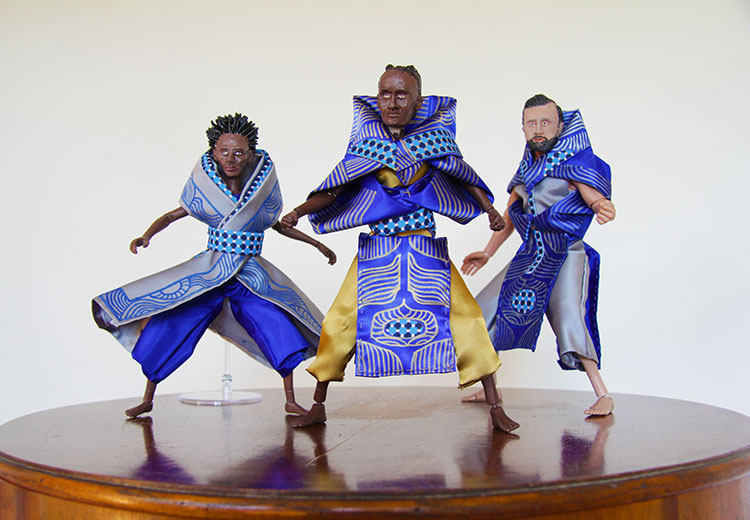
Hetain Patel. Plastic Dreams, 2020. Series of action figure toys based on characters from Hetain Patel's films.
CR: You make the faces yourself.
HP: Yes, but I never intended doing so. It was the only way to do it. I do like making and I learn from things and they give me ideas, but the vision for those works is to have masses of them – to a point where they are affordable to buy in a gallery or gift shop and end up in people’s homes.
I went to a toy fair and had consultations with these amazing toy companies. A few were up for it; it was a fascinating process. I was trying to find a way of them making them and getting a licence. You’ve got to think outside of what we can do in the arts.
CR: Surely you’re going to revisit this idea …
HP: Yes, the idea with the trilogy of films I am working on is that these figures are from the films. So, you can watch the cinematic works, then leave the cinema and walk away with one of the figures.
But it’s not just for the fun of it. I’m interested in the massive power over our culture these industries have. I’m interested in the fact that my nieces and nephews, who love to dress up, can’t dress up as anyone who looks like them. What does it do growing up to see that the only heroic version of masculinity I can be is white. My figures will all be people of colour, non-normative bodies, but made with the seductive quality of amazing costumes. They could be in someone’s home and childhood fantasies could change.
CR: You won the Film London Jarman Award 2019. What implications does this prize have for your practice?
HP: Nothing has changed overnight. The challenges about being recognised as a British artist are still there. I’m not sure everyone suddenly seeing me win the Jarman will think of me when they’re thinking of other British artists. But then maybe some will. Obviously, it carries a profile and kudos. That does, and is, helping me. I always followed the award, and winning it has made me realise how many people here and internationally know about it. I’m sure the exposure will continue to play out.
On a very practical level, the £10,000 prize is substantial for a person like me. I’m not a rich artist, so it has bought me some time to say no to some things and concentrate on the next film. It gives you a lot of self-confidence. At the minute, you sort of find yourself balancing self-confidence and good stuff with guilt around the reality for lots of other artists. The Jarman is a competitive thing and there are lots of artists who have been nominated and shortlisted several times and never won. Like with any funding or opportunities, artists don’t thrive on being in competition with one another. Part of the process also highlighted for me that some of these artists you think have made it, we’re actually often in the same ship, we’re not all raking it in and living it sweet.
CR: The financial dimensions of working in the arts are something you have touched on before.
HP: Yes, I made a series of talks last year where I was transparent about my income. It was in Manchester and part of these online talks about money from the kitchen of a residency I was doing. Each day, I would invite artists and curators to have a frank conversation about money. People are often surprised that I’m not making lots of money and, conversely, I’m surprised when I hear that about other artists I think are established. The exposure of the Jarman Award also highlights the disparity. The battle is always to try to put a pin in that part which feels guilty and try to use the momentum of it to keep building.
CR: What’s happening next?
HP: The film projects are my babies, as it were, and they take a long time. The next film project has been gestating since Don’t Look at the Finger, which launched at the end of 2017. I spent a long time building partners and fundraising and I’m still in the later stages of that, but it’s all looking positive. I’m proper excited about it.